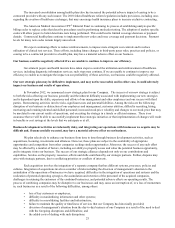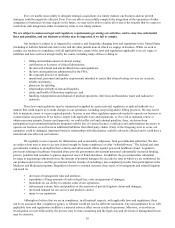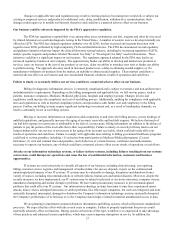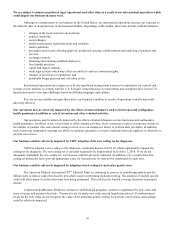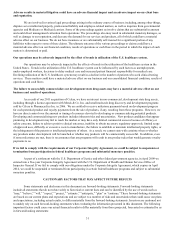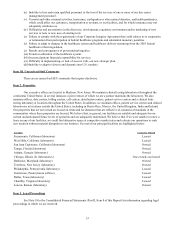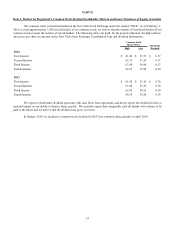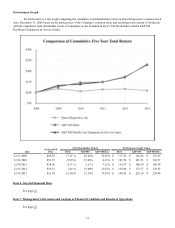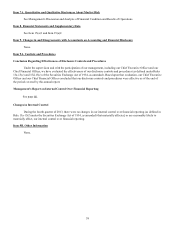Quest Diagnostics 2013 Annual Report Download - page 32
Download and view the complete annual report
Please find page 32 of the 2013 Quest Diagnostics annual report below. You can navigate through the pages in the report by either clicking on the pages listed below, or by using the keyword search tool below to find specific information within the annual report.28
implementation process, including the transfer of databases and master files to new data centers, presents significant conversion
risks that need to be managed carefully.
If we experience systems problems, including with our implementation of common laboratory or billing systems, they
may interrupt our ability to operate. For example, the problems may impact our ability to process test orders, deliver test results
or perform or bill for testing in a timely manner.
If we experience systems problems, or if we experience unauthorized disclosure of confidential information, it could
adversely affect our reputation, result in a loss of customers and revenues and cause us to suffer financial damage, including
significant costs to alleviate or eliminate the problem.
Failure to develop, or acquire licenses for, new tests, technology and services could negatively impact our testing volume
and revenues.
The clinical testing industry is faced with changing technology and new product introductions. Other companies or
individuals, including our competitors, may obtain patents or other property rights that would prevent, limit or interfere with
our ability to develop, perform or sell our tests or operate our business or increase our costs. In addition, they could introduce
new tests, technologies or services that may result in a decrease in the demand for our services or cause us to reduce the prices
of our services. Our success in continuing to introduce new tests, technology and services will depend, in part, on our ability to
license new and improved technologies on favorable terms. We may be unable to develop or introduce new tests or services.
We also may be unable to continue to negotiate acceptable licensing arrangements, and arrangements that we do conclude may
not yield commercially successful clinical tests. If we are unable to license these testing methods at competitive rates, our
research and development costs may increase as a result. In addition, if we are unable to develop and introduce, or license, new
tests, technology and services to expand our esoteric testing business, our services may become outdated when compared with
our competition and our revenue may be materially and adversely affected.
We may be unable to obtain, maintain or enforce our intellectual property rights and may be subject to intellectual
property litigation that could adversely impact our business.
We may be unable to obtain or maintain adequate patent or other proprietary rights for our products and services or to
successfully enforce our proprietary rights. In addition, we may be subject to intellectual property litigation and we may be
found to infringe on the proprietary rights of others, which could force us to do one or more of the following:
• cease developing, performing or selling products or services that incorporate the challenged intellectual property;
• obtain and pay for licenses from the holder of the infringed intellectual property right;
• redesign or reengineer our tests;
• change our business processes; or
• pay substantial damages, court costs and attorneys' fees, including potentially increased damages for any
infringement held to be willful.
The development of new, more cost-effective tests that can be performed by our customers or by patients, and the
continued internalization of testing by hospitals or physicians, could negatively impact our testing volume and revenues.
The diagnostic information services industry is faced with changing technology and new product introductions,
including technology that enables more convenient or cost-effective testing. Competitors also may offer testing to be
performed outside of a commercial clinical laboratory, such as (1) point-of-care testing that can be performed by physicians in
their offices; (2) complex testing that can be performed by hospitals in their own laboratories; and (3) home testing that can be
carried out without requiring the services of outside providers. Advances in technology also may lead to the need for less
frequent testing. Further, diagnostic tests approved or cleared by the FDA for home use are automatically deemed to be
“waived” tests under CLIA and may be performed by patients in their homes; test kit manufacturers could seek to increase sales
to patients of such test kits. Development of such technology and its use by our customers would reduce the demand for our
laboratory-based testing services and negatively impact our revenues.
Some traditional customers for anatomic pathology services have added in-office histology labs or have retained
pathologists to read cases on site, thus allowing them to bill for services previously referred to outside pathology service
providers, such as the Company. These customers include specialty physicians that generate biopsies through surgical
procedures, such as dermatologists, gastroenterologists, urologists and oncologists. If our customers continue to internalize
testing that we currently perform, the demand for our testing services may be reduced and our revenues may be materially
adversely impacted.









